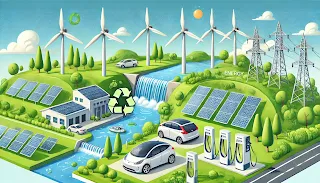Introduction
As the world faces increasing environmental challenges, the role of technology in promoting sustainability has never been more critical. Innovations in various sectors are helping to reduce waste, conserve resources, and create a more sustainable future. In this post, we will explore key technological advancements contributing to environmental sustainability, highlighting their applications and impact.
1. Renewable Energy Technologies
Solar Power: The adoption of solar panels has surged, allowing homeowners and businesses to harness solar energy. Solar farms are now commonplace, generating clean energy at scale. Innovations in solar technology, such as photovoltaic cells and solar thermal systems, are making solar power more efficient and accessible.
Wind Energy: Wind turbines have become a prominent source of renewable energy. Advances in turbine design and offshore wind farms are significantly increasing energy output while reducing costs. Wind energy is one of the fastest-growing sources of clean energy globally.
Hydroelectric Power: Hydroelectric plants use flowing water to generate electricity. Modern technologies are improving the efficiency and environmental impact of these systems, allowing for sustainable energy generation with minimal ecological disruption.
2. Smart Agriculture
Precision Farming: Technology is transforming agriculture through precision farming techniques. Farmers use sensors, drones, and GPS technology to monitor crops and optimize resource usage, leading to higher yields with lower environmental impact. For example, soil moisture sensors help farmers apply the right amount of water, reducing waste.
Vertical Farming: This innovative approach allows for food production in urban areas using controlled environments. Vertical farms use less land and water compared to traditional farming, minimizing environmental footprint while providing fresh produce.
Biotechnology: Genetically modified organisms (GMOs) can lead to crops that require fewer pesticides and water. This technology helps improve food security while reducing agriculture's environmental impact.
3. Waste Management Solutions
Recycling Technology: Advanced recycling technologies, such as automated sorting systems and chemical recycling, enhance the efficiency of recycling processes. These innovations allow for better recovery of materials and reduced landfill waste.
Waste-to-Energy: Converting waste into energy through incineration or anaerobic digestion generates electricity while reducing the volume of waste in landfills. These technologies contribute to a circular economy by transforming waste into valuable resources.
Smart Waste Management: IoT devices are being used to optimize waste collection routes and schedules. Smart bins equipped with sensors can monitor fill levels, enabling cities to reduce operational costs and improve efficiency.
4. Sustainable Transportation
Electric Vehicles (EVs): The shift towards electric vehicles is revolutionizing transportation. With advancements in battery technology, EVs are becoming more affordable and have greater range capabilities. The use of EVs helps reduce greenhouse gas emissions and dependency on fossil fuels.
Public Transportation Innovations: Smart public transportation systems are being developed to reduce congestion and emissions. Real-time tracking, mobile apps, and integrated ticketing systems improve the efficiency of public transit, encouraging more people to use these sustainable options.
5. Smart Building Technologies
Energy-Efficient Design: New building technologies focus on energy efficiency, incorporating smart thermostats, LED lighting, and energy management systems. These innovations reduce energy consumption and lower utility costs.
Green Building Certifications: Technologies that support sustainable construction practices help buildings earn certifications like LEED (Leadership in Energy and Environmental Design). These certifications promote environmentally responsible construction and operation.
Conclusion
The integration of technology into efforts for environmental sustainability is paving the way for a greener future. From renewable energy sources to smart agriculture and efficient waste management, technological innovations are making significant strides in reducing our ecological footprint. As we continue to explore and invest in these technologies, we can create a sustainable world for generations to come.









0 Comments